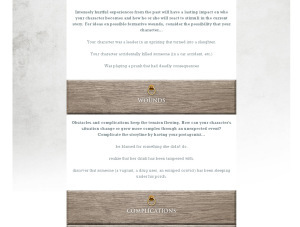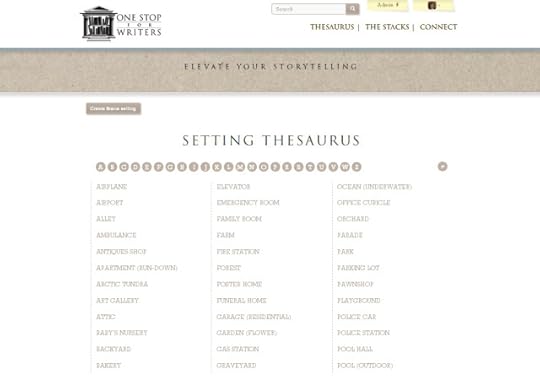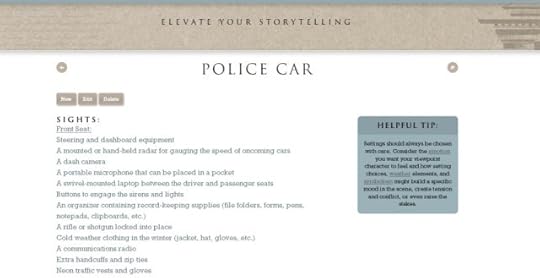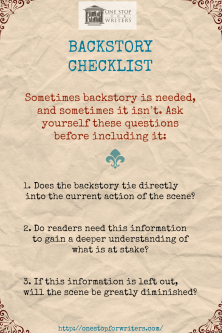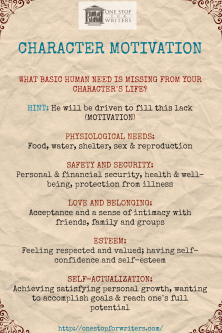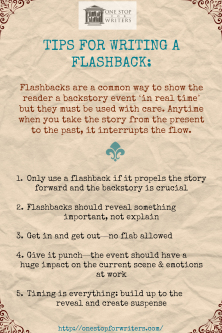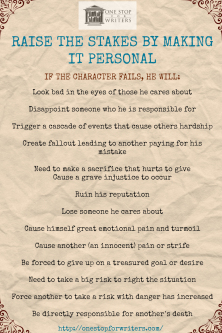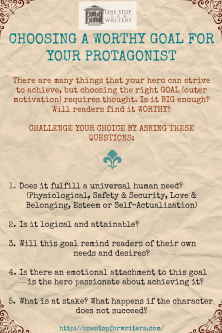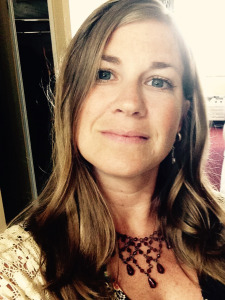Angela Ackerman's Blog: Writers Helping Writers, page 145
October 15, 2015
Planning a Novel: Character Arc In A Nutshell
It’s NaNoWriMo Season, and that means a ton of writers are planning their novels. Or, at the very least (in the case of you pantsers) thinking about their novel.
Whether you plot or pants, if you don’t want to end up in No Man’s Land halfway to 50K, it is often helpful to have a solid foundation of ideas about your book. So, let’s look at the biggie of a novel: Character Arc. If you plot, make some notes, copious notes! If you pants, spend some time mulling these over in the shower leading up to November 1st. Your characters will thank you for it!
A new book. Are you excited? I hope so. You’re about to create a new reality!
Can you imagine it, that fresh page that’s full of potential? Your main character is going to…um, do things…in your novel. A great many things! Exciting things. Dangerous things. There might even be a giant penguin with lasers shooting out of its eyes, who knows?
But here’s a fact, my writing friend…if you don’t know WHY your protagonist is doing what he’s doing, readers may not care enough to read beyond a chapter or two.
The M word…Motivation
It doesn’t matter how well drawn your hero is or what cool and trippy things he does in a story…if readers don’t understand the WHY behind his actions, they won’t connect to him. We’re talking about Motivation, something that wields a lot of power in any story. It is the thread that weaves through a protagonist’s every thought, decision, choice and action. It propels him forward in every scene.
Because of this, the question, What does my character want? should always be in the front of your mind as you write. More importantly, as the author, you should always know the answer.
Outer Motivation – THE BIG GOAL (What does your character want?)
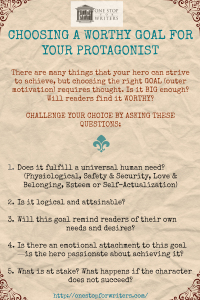 Your character must have a goal of some kind, something they are aiming to achieve. It might be to win a prestigious award, to save one’s daughter from kidnappers, or to leave an abusive husband and start a new life. Whatever goal you choose, it should be WORTHY. The reader should understand why this goal is important to the hero or heroine, and believe they deserve to achieve it.
Your character must have a goal of some kind, something they are aiming to achieve. It might be to win a prestigious award, to save one’s daughter from kidnappers, or to leave an abusive husband and start a new life. Whatever goal you choose, it should be WORTHY. The reader should understand why this goal is important to the hero or heroine, and believe they deserve to achieve it.
Inner Motivation – UNFULFILLED NEEDS (Why does the protagonist want to achieve this particular goal?)
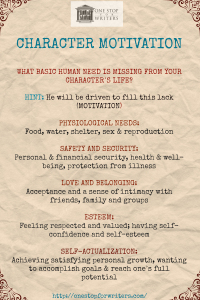 Fiction should be a mirror of real life, and in the real world, HUMAN NEEDS DRIVE BEHAVIOR. Yes, for you psychology majors, I am talking about Maslow’s Hierarchy of Human Needs. Physical needs, safety and security, love and belonging, esteem and self-actualization are all part of what it is to be human.
Fiction should be a mirror of real life, and in the real world, HUMAN NEEDS DRIVE BEHAVIOR. Yes, for you psychology majors, I am talking about Maslow’s Hierarchy of Human Needs. Physical needs, safety and security, love and belonging, esteem and self-actualization are all part of what it is to be human.
If you take one of these needs away, once the lack is felt strongly enough, a person will be DRIVEN to gain it back. The need becomes so acute it can no longer be ignored–it is a hole that must be filled.
If someone was threatening your family (safety and security) what might you do to keep loved ones safe? If each day you went to a workplace where you were treated poorly by your boss (esteem), how long until you decide to look for a new job? These needs are real for us, and so they should be real for our characters. Ask yourself what is missing from your character’s life. Why do they feel incomplete? The story becomes their journey to fill this lack.
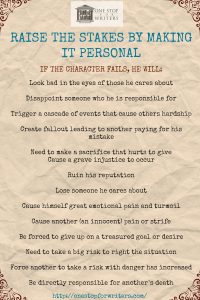 Outer Conflict – THE WHO or WHAT (that stands in the way of your hero achieving his goal)
Outer Conflict – THE WHO or WHAT (that stands in the way of your hero achieving his goal)If your story has an antagonist or villain, you want to spend some solid time thinking about who they are, why they’re standing in the hero’s way, and what motivates them to do what they do.
The reason is simple…the stronger your antagonist is, the harder your hero must work to defeat him. This also means the desire of achieving the goal must outweigh any hardship you throw at your hero, otherwise he’ll give up. Quit. And if he does, you’ll have a Tragedy on your hands, not the most popular ending.
Our job as authors is to challenge our heroes, and create stakes high enough that quitting isn’t an option. Often this means personalizing the stakes, because few people willingly put their head in an oven. So make failure not an option. Give failure a steep price.
The problem is that with most stories, to fight and win, your character must change. And change is hard. Change is something most people avoid, and why? Because it means taking an honest look within and seeing one’s own flaws. It means feeling vulnerable…something most of us seek to avoid. This leads us to one of the biggest cornerstones of Character Arc.
Inner Conflict – The STRUGGLE OVER CHANGE (an internal battle between fear and desire, of staying chained to the past or to seek the future)
To achieve a big goal, it makes sense that a person has to apply themselves and attack it from a place of strength, right? Getting to that high position is never easy, not in real life, or in the fictional world. In a novel, the protagonist has to see himself objectively, and then be willing to do a bit of housecleaning.
What do I mean by that?
Characters, like people, bury pain. Emotional wounds, fears, and vulnerability are all shoved down deep, and emotional armor donned. No one wants to feel weak, and when someone takes an emotional hit after a negative experience, this is exactly what happens. They feel WEAK. Vulnerable.
The Birth of Flaws
What is emotional armor? Character Flaws. Behaviors, attitudes and beliefs that a character adopts as a result of a wounding event. Why does this happen? Because flaws minimize expectations and keep people (and therefore their ability to cause further hurt) at a distance. But in doing so, flaws create dysfunction, damage the protagonist’s relationships and prevent his personal growth. And due to their negative nature, flaws also tend to get in the way, tripping the character up and prevent him from success.
Facing Down Fear
Fear, a deeply rooted one, is at the heart of any flaw. The character believes that the same painful experience (a wound or wounds) will happen again if unchecked. This belief is a deeply embedded fear that blinds them to all else, including what is holding them back from achievement and happiness.
To move forward, the protagonist must see his flaws for what they are: negative traits that harm, not help. He must choose to shed his flaws and face his fears. By doing this, he gains perspective, and views the past in a new light. Wounds no longer hold power. False beliefs are seen for the untruths they are. The character achieves insight, internal growth, and fortified by this new set of beliefs, is able to see what must be done to move forward. They finally are free from their fear, and are ready to make the changes necessary to achieve their goal.
Why Does Character Arc Hold Such Power Over Readers?
This evolution from “something missing” to “feeling complete” is known as achieving personal growth in real life, which is why readers find Character Arc so compelling to read about. As people, we are all on a path to becoming someone better, someone more whole and complete, but it is a journey of a million steps. Watching a character achieve the very thing we all hope to is very rewarding, don’t you think?
Need a bit more help with some of the pieces of Character Arc? Try these:
Why Is Your Character’s Emotional Wound So Important?
Emotional Wounds: A List Of Common Themes
The Connection Between Wounds and Basic Human Needs
Flaws, Emotional Trauma and The Character’s Wound
Make Your Hero Complex By Choosing The Right Flaws
Explaining Fears, Wounds, False Beliefs and Basic Needs
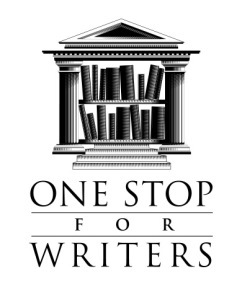 And did you know…
And did you know…The bestselling books, The Emotion Thesaurus, The Negative Trait Thesaurus and The Positive Trait Thesaurus are all part of One Stop For Writers, along with many other upgraded and enhanced description collections?
You can also access many workshops and templates to help with Character Arc, or take our Character Wound & Internal Growth Generators for a spin.
Are you NaNoing this year? How is your Character Arc coming along? Let me know in the comments!
Before you go…
Becca is over at The Creative Penn and W-O-W does she have something special for you. This post is unmissable if you want to learn how to elevate your description in a way that sticks with readers. Have a read and bookmark it, because chances are you’ll want to come back to it more than once! The Art Of Turning A Unique Phrase
The post Planning a Novel: Character Arc In A Nutshell appeared first on WRITERS HELPING WRITERS™.
October 14, 2015
Inside One Stop For Writers: The Idea Generator
Did you also get your 50% off code? Just see the bottom of this post!
 Looking Inside One Stop For Writers: The Idea Generator
Looking Inside One Stop For Writers: The Idea GeneratorToday I’d like to talk about the Idea Generator, one of the neat tools you can find at the One Stop library. Chances are you’ve seen generators before…some of which spit out a mish-mash story idea that sounds a bit like this:
“A fire-breathing mega turtle teams up with a one-armed hobgoblin thief to steal the secret elixir hidden in the acid forest of Dune Town.“
Now I don’t know about you, but I find most generators that follow a person/place/thing format rarely shake loose anything helpful. So, when we created the Idea Generator, we chose to go a different route.
We mainly look at areas of character exploration that are can be hard to brainstorm without a mental nudge or two: Emotional Wounds, Character Fears, Areas of Internal Growth (Character Arc), Likable Qualities & Behaviors, Quirks and Secrets. Then to round things out, we also provide Plot Complications and Story Prompts. (Click image to enlarge)
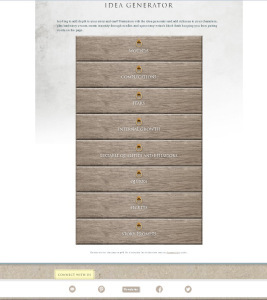
Each drawer opens to reveal three different ideas, and you can open the drawer as many times as you need to find the right fit. Then, once you find a fit, leave the drawer open, and move on to another area to explore!
Pretty soon, you will be full of ideas, and by keeping drawers open you can keep track of the generated ideas by cutting and pasting them into your “My Notes,” a personal note-taking feature at One Stop. Pretty cool huh?
A Note On “My Notes”
One nice extra of One Stop is “My Notes” which allows a user to create and save private notes on pretty much anything they would like to. For example, every thesaurus entry has the ability to “add a note” to it, allowing you to customize the entry. Maybe you have thought of a few additional ways to describe a Forest or Lake. Just add a note, and your ideas will stay attached to that entry moving forward!
If you would like to check out the Idea Generator, just take 5 seconds to register (it’s free). Once you have a free account, you will be able to check out the site, see the different thesaurus collections, view template examples, start creating notes, read tutorials and visit the generator page. (Note however that the Idea Generator will not open without a subscription.)
Have you been to One Stop For Writers yet? Today is the last day to get your subscription at 50% off. Here’s how:
1) Register at One Stop For Writers (“sign up”)
2) Go to the Yellow Avatar tab at the top right and select “My Subscriptions”
3) Cut and Paste this code into the coupon box BEFORE selecting a plan:
Elevate_Your_Storytelling_50
4) Click “Activate” and the coupon box will disappear.
5) Connect a credit card (your information is completely secure, stored by the exceptional provider Stripe, not One Stop For Writers)
6) Select a plan (the coupon will be applied to your credit card charge)
And that’s it, you’re officially a V.I. P. at One Stop and the library is at your disposal. Hope to see you there.
Happy writing!
Angela
The post Inside One Stop For Writers: The Idea Generator appeared first on WRITERS HELPING WRITERS™.
October 11, 2015
Inside One Stop For Writers: Unique Templates & Worksheets
Also, don’t forget to snag a special Launch week code giving you 50% off ANY PLAN at One Stop For Writers.
For all the details, follow this link!
A Look Inside One Stop’s Templates & Worksheets
As you can imagine with an online library, there are many nooks and crannies to explore. One of my favorite places is up in The Stacks where we keep our Templates and Worksheets. (click to enlarge)
Pictured above is the Character Fears Template. By following the prompts, you brainstorm a character’s secrets, failures, greatest mistakes, relationship issues, wounding events, situations he avoids, the lies he believes, etc. so it uncovers the thing he fears most…which, in Character Arc, is the very thing he must face and defeat to become whole and achieve his objective or goal.
Templates are easy to use. You can fill them out right at One Stop and the information transforms into a helpful “wheel” showing how everything ties together. This is terrific for planning and plotting, and will also help keep you focused on your character’s motivation in each scene. Once a Template is created, you can save and access it onsite, or export it to your computer for printing. Try creating one for each character in your book!
(We’re also building new ones as we go, so if you have an idea for a template or worksheet that you’d really like to see, make sure to submit your Wishlist Idea through the CONNECT button at One Stop.)
If you aren’t a member yet, don’t worry! You can register at any time for free and poke around. Go check out the Templates and Worksheets for yourself, and see what you think!
Happy Writing,
Angela, Becca & Lee
The post Inside One Stop For Writers: Unique Templates & Worksheets appeared first on WRITERS HELPING WRITERS™.
October 9, 2015
Inside One Stop For Writers: Our Descriptive Thesaurus Collections
If not, follow this link for all the details, and good luck!
 As some of you know, the heart of One Stop For Writers is our signature Descriptive Thesaurus Collection. Visitors to this blog (and The Bookshelf Muse before it) have watched Becca and I create highly-sensory, real-life description lists for many different areas (Character Emotions, Settings, Symbolism and Weather, just to name a few.) Delving deep to understand these aspects of description allows us to write rich, compelling stories. So, when writers asked us to, we started turning a few into books.
As some of you know, the heart of One Stop For Writers is our signature Descriptive Thesaurus Collection. Visitors to this blog (and The Bookshelf Muse before it) have watched Becca and I create highly-sensory, real-life description lists for many different areas (Character Emotions, Settings, Symbolism and Weather, just to name a few.) Delving deep to understand these aspects of description allows us to write rich, compelling stories. So, when writers asked us to, we started turning a few into books.
Now we’re writers, and we love books! But the list format we use isn’t always an easy read in digital format, and often requires a lot of scrolling to see an entire entry. We knew there had to be a better way.
Lucky for us Lee Powell, the creator of Scrivener for Windows, is a genius. He could see how the right medium would turn our thesaurus collections into a top notch resource for writers that would be super easy to use.
At One Stop, each thesaurus is neatly organized and entries are easy to view. A Helpful Tip guides writers into thinking about how an area of description can be woven into the story to do more, and show more. There’s a tutorial for each thesaurus as well, helping writers understand the power of specific detail and how it can be used in the story for maximum effect.
(click to enlarge–a partial screenshot)
Setting is a big area of description. So much more than a backdrop for a scene, it is loaded with opportunities to convey mood, foreshadow, and act as a tuning fork for symbolism and theme. And that’s just to start! Using sensory details when describing your character in a specific location is important for pulling readers into the story.
You might be wondering how authentic the description is for each of our Setting entries. Well, whenever possible, Becca and I would visit the location ourselves so we could observe the sights, smells, sounds, textures and tastes first hand. The entire Setting Collection (once it is finished) will be around 250 entries. That’s a lot of research.
 It wasn’t easy to visit some locations, but we were determined. As you can see in this photo…well, sometimes we had to go to great lengths to get exact detail.
It wasn’t easy to visit some locations, but we were determined. As you can see in this photo…well, sometimes we had to go to great lengths to get exact detail.
(In case you were wondering, it is rather terrifying being arrested, even when it involves being set up by relatives with connections so you can get the “full experience” of being handcuffed and put into the back of police car!)
So, let’s just say the details in this particular entry are very accurate. If you like, swing by One Stop and check it out for yourself!
Before you head off with the rest of your day, there’s one more cool thing happening:
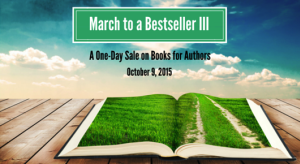 March To A Bestseller’s One-Day sale. This is where you can get a kindle copy of many great writing craft books (INCLUDING The Emotion Thesaurus) for .99 cents each. Yep, a buck! There are many great authors participating such as K.M. Weiland, Mary Buckham, Bryan Cohen, Jessica Bell and more, so if you’re looking to beef up on your writing skills, now’s the time.
March To A Bestseller’s One-Day sale. This is where you can get a kindle copy of many great writing craft books (INCLUDING The Emotion Thesaurus) for .99 cents each. Yep, a buck! There are many great authors participating such as K.M. Weiland, Mary Buckham, Bryan Cohen, Jessica Bell and more, so if you’re looking to beef up on your writing skills, now’s the time.
![Pageflex Persona [document: PRS0000046_00058]](https://i.gr-assets.com/images/S/compressed.photo.goodreads.com/hostedimages/1444438238i/16500206.jpg) I don’t anticipate The Emotion Thesaurus: A Writer’s Guide to Character Expression
I don’t anticipate The Emotion Thesaurus: A Writer’s Guide to Character Expression
will be priced at .99 cents again, so if you have a writing partner or critique group who doesn’t yet have our resource, feel free to let them know.
Click to tweet: Love The Emotion Thesaurus: A Writer’s Guide To Character Expression? Today it’s only .99 cents: http://ctt.ec/U2KoC+ #amwriting
Also-ALSO,
Becca is over at Kristen Lamb’s (she is a national treasure–I hope you are all following this blog!) discussing Making Story MAGIC—How To Bring the Elements All Together. Feel free to check it out!
And I am over at Romance University discussing How Characters Often Resist Attraction in Romance, and How To Show Their Body Language Struggle (plus I’m sharing some great body language cheat sheets for HIM and HER!)
Happy writing,
Angela
The post Inside One Stop For Writers: Our Descriptive Thesaurus Collections appeared first on WRITERS HELPING WRITERS™.
October 6, 2015
The One Stop For Writers Library Is Now Open!
Pass around the party blowers and get your confetti ready, because today we’re launching One Stop For Writers, a powerhouse online library to help writers elevate their storytelling.
This site has been in the works for a year, a collaboration between Becca, Lee Powell (the talented creator of Scrivener for Windows), and me. We are thrilled to throw open our One Stop library doors at last.
What will you find inside One Stop For Writers?
11 extensively developed Descriptive Thesaurus Collections, including content from the bestselling Emotion, Positive and Negative Trait books, as well as the upcoming Setting Thesaurus volumes (Spring 2016 release)
An Idea Generator that pushes Writer’s Block aside while helping you plan stunning, deep characters by exploring possible emotional wounds, fears, and areas of internal growth (along with other aspects of story development)
Unique Worksheets and Templates to assist with character building, setting planning, scene-by-scene emotional escalations, symbolism, and more (export and print friendly)
Tutorials that promote a greater understanding of story and character development and allow writers to do more with less when it comes to crafting meaningful description
The ability to customize descriptive entries by creating notes and ideas to save for future use
Intuitive links and an advanced search function to help writers find what they need quickly so they spend less time researching and more time writing
And this is only the beginning.
Becca, Lee, and I look forward to adding new enhancements, lessons, creative tools, and descriptive collections to help you grow into a stronger, more prolific writer!
Do you need One Stop For Writers? Pop in and find out.
 Register to check out the free version and get an idea of what we offer, and if you like, take advantage of this SWEET launch week deal by using this coupon:
Register to check out the free version and get an idea of what we offer, and if you like, take advantage of this SWEET launch week deal by using this coupon:
Elevate_Your_Storytelling_50
to get 50% off any first-time subscriber plan…1 month, 6 months or 1 full year.
Simply cut and paste the above code into the coupon box on the subscription page BEFORE selecting a plan. It’s that easy. You can find our pricing & plans here. Please note this coupon must be used by October 14th.
Win, Win Win!
Also, to help everyone get into the party mood, we’re paying-it-forward with some terrific writerly education. One winner will snag a seat in the extremely popular Lost Your Pants? The Impatient Writer’s Guide to Plotting a Story class, with writing coach and author Jami Gold. This winner will also receive Jami’s On Demand workshop: Beat Sheet Basics: Know Your Story Structure. These two phenomenal workshops will give someone a terrific window into how to create page-turners with tight story structure and deep character development—all while learning how to write faster, too. With NaNoWriMo coming up, this workshop could not be better timed!
Follow the links above for more information and please note: the Lost Your Pants class takes place in two parts on October 13 & 15th. Should the winner be unable to attend live, a recording will be provided. Draw closes October 11th, 6:30 PM EST.
Win, Win, Win! (Part 2)
You like to win things. We like to give things. It’s a perfect match, don’t you think? So, we’ve rustled up SEVEN 1-year subscriptions for One Stop. How many words could you get on the page with all these resources at your fingertips for an entire year? Let’s find out! Draw closes October 14 th, 6:30 PM EST.
As always, these giveaways are free to enter, no purchase necessary, and are open to anyone over the age of 18 unless prohibited by law. Just fill out THIS FORM to enter. Full legal details here.
The library is open, and your readers are waiting. Let us help you plan and create, so you can get those words down on the page.
Happy writing from your One Stop Librarians,
Angela, Becca, & Lee
(If you are so inclined, feel free to share this post! And thank you for all your support of this crazy new adventure of ours.)
The post The One Stop For Writers Library Is Now Open! appeared first on WRITERS HELPING WRITERS™.
October 5, 2015
Unique Writing Resources: Helpful Checklists and Tip Sheets
It’s hard to believe we’re only two short days away from opening the doors to the One Stop library. This is going to sound a bit baffling, but in some ways it hasn’t hit me yet. It’s a bit like a publishing a book: you plan, work, and strengthen your project, and it becomes your life. Then one day, boom, it’s out the door or uploaded and you feel…adrift.
It’s like your brain hasn’t clued in that everything has changed and the piece of yourself that you’ve held onto so tightly is now about to become something that belongs to other people too.
Well, One Stop For Writers is polished and waiting to become the online library it was meant to be. Lee, Becca and I are very excited, and hope it becomes a game-changing tool for a few writers out there. Because this is such a labor of love, we’re looking forward to adding to it over time, bringing even more value to everyone who uses it.
Writing Checklist Nirvana
As the “marketing department” of our little merry band, I created a bunch of imaged-based sharables that provide good value to writers: an assortment of check lists and tip sheets on different areas of writing that can be hard to master. Each one ties into our signature descriptive thesaurus collections and teachings.
My intent leading into launch was to offer something that would be shared openly online, and help get the One Stop For Writers name out there. Thanks to the terrific efforts of an amazing street team, the idea worked and we’ve achieved some discoverability. I’m linking to a few here for you to use in case you haven’t yet come across them. There are many more available on our special One Stop Pinterest board, too, along with some dark writing prompts and emotional showing tips.
(click each to enlarge)
Also, if you go HERE, you’ll find many topic-specific writing boards we’ve put together under the One Stop For Writers banner. With so many articles out there on writing, it can be exhausting to know which ones pack the biggest value punch. This should help make it a bit easier to find the best of the best when it comes to writing advice.
Enjoy & happy writing!
Angela
The post Unique Writing Resources: Helpful Checklists and Tip Sheets appeared first on WRITERS HELPING WRITERS™.
October 3, 2015
Emotional Wound Entry: Growing Up in a Dangerous Neighborhood
When you’re writing a character, it’s important to know why she is the way she is. Knowing her backstory is important to achieving this end, and one of the most impactful pieces of a character’s backstory is her emotional wound. This negative experience from the past is so intense that a character will go to great lengths to avoid experiencing that kind of pain and negative emotion again. As a result, certain behaviors, beliefs, and character traits will emerge.
Characters, like real people, are unique, and will respond to wounding events differently. The vast array of possible emotional wounds combined with each character’s personality gives you many options in terms of how your character will turn out. With the right amount of exploration, you should be able to come up with a character whose past appropriately affects her present, resulting in a realistic character that will ring true with readers. Understanding what wounds a protagonist bears will also help you plot out her arc, creating a compelling journey of change that will satisfy readers.
 NOTE: We realize that sometimes a wound we profile may have personal meaning, stirring up the past for some of our readers. It is not our intent to create emotional turmoil. Please know that we research each wounding topic carefully to treat it with the utmost respect.
NOTE: We realize that sometimes a wound we profile may have personal meaning, stirring up the past for some of our readers. It is not our intent to create emotional turmoil. Please know that we research each wounding topic carefully to treat it with the utmost respect.
Examples:
Living in a high crime area
One’s neighborhood having a strong gang presence that pressures one to join
Gangs fighting over territory
A location stalked by a specific predator (human or otherwise)
A war-torn area where bombings, mine fields or gun violence is a constant threat
Militant groups that perform routine kidnappings and violence
Biological or chemical threats
Poverty that gives rise to desperation and fighting over resources
A prominent drug trafficking location
Living in an area where one is not only unwelcome, but despised (for one’s beliefs, religious affiliations, race, etc.)
Living in a place that has been abandoned by police or one’s government for political reasons
Basic Needs Often Compromised By This Wound: physiological needs, safety and security, love and belonging, esteem and recognition, self-actualization
False Beliefs That May Be Embraced As a Result of This Wound:
I can’t escape this type of life
The world doesn’t care about people like me
The only way to survive is to become what I hate
The only way I can have anything is to take it
There’s no justice in this world
I am not strong enough or powerful enough to stand up against (a group, a gang, etc.)
Nothing I do will change anything
The end justifies the means
If I don’t (take it, do it, etc.) someone else will
All (people of a specific race, affiliation, religion, etc.) are evil (or corrupt, dangerous, or fill-in-the-blank)
No one will take care of me–I have to do it myself
Positive Attributes That May Result: adaptable, alert, bold, cautious, disciplined, discreet, focused, idealistic, independent, just, loyal, nurturing, observant, persistent, private, proactive, protective, simple, spiritual, thrifty
Negative Traits That May Result: abrasive, addictive, apathetic, callous, confrontational, cruel, cynical, dishonest, evasive, fanatical, hostile, impatient, irrational, judgmental, manipulative, macho, nervous, pessimistic, rebellious, reckless, self-destructive, stubborn, suspicious, timid, volatile, worrywart
Resulting Fears:
fear of being hurt or killed
fear of not being able to protect one’s family
fear of being taken advantage of
fear of trusting the wrong person
fear of violence
fear of a specific people group
fear of one’s government or those in power
Possible Habits That May Emerge:
constant checking of one’s surroundings for danger, even if not consciously aware of this behavior
not always being genuine and honest with people
pretending to be something one is not
putting up a wall around one’s emotions
being uncommunicative with others
taking chances or behaving recklessly
having a difficult time taking people at their word
pessimism and negativity
becoming highly protective of one’s family and home
pushing one’s children to make better choices
passing on one’s biases onto one’s children
Prioritizing security (locks, home protection, etc.) and hiding things
Mistrust of strangers and authority
TIP: If you need help understanding the impact of these factors, please read our introductory post on the Emotional Wound Thesaurus. For our current list of Emotional Wound Entries, go here.
For other Descriptive Thesaurus Collections, go here.
The post Emotional Wound Entry: Growing Up in a Dangerous Neighborhood appeared first on WRITERS HELPING WRITERS™.
September 28, 2015
Dream Up A Great Book Idea & Make Something Of It
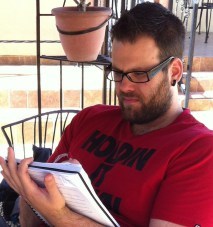 Hi everyone! Before we get into today’s post, let me just say that Becca is over at Positive Writer today, talking about how a business plan can help writers with their day-to-day decision making. As our careers develop, we get more requests, more opportunities, and it’s hard to figure out when to say yes or no. If this is a struggle for you, you might want to head over to Positive Writer and check it out.
Hi everyone! Before we get into today’s post, let me just say that Becca is over at Positive Writer today, talking about how a business plan can help writers with their day-to-day decision making. As our careers develop, we get more requests, more opportunities, and it’s hard to figure out when to say yes or no. If this is a struggle for you, you might want to head over to Positive Writer and check it out.
I’m so happy to introduce Andy Peloquin, who is a first timer here at WHW with some great ideas to share on shaking the creativity tree for ideas, and then transforming them into something useful. Please read on!
Where Do Great Ideas Come From?
It’s funny how science still has no idea where ideas come from or how they are formed. What part of the brain do they begin and end in? Are they nothing more than electrical impulses between the hemispheres of the brain? If so, how are they transformed into something usable? How does a simple electrical signal end up in the form of a masterpiece like Michelangelo’s David, Van Gogh’s Starry Night, or Terry Pratchett’s Discworld?
Take a look, if you will, at Brandon Sanderson’s The Rithmatist. It’s an entire magical system based on chalk drawings! I’d be willing to bet that he saw some random children drawing on the sidewalk and thought, “Now that’s an interesting idea!”
We don’t really know how ideas are formed, but how do they become something more than just a “brain fart”? How do we transform them from a “cool idea” into an entire concept?
My inspiration comes from the most unique, unusual places. In my brand new series, The Last Bucelarii, the hero is an assassin (an anti-hero, my personal favorite sort). But he’s something much more than human. Stronger, faster, and better than humans, he can’t be killed. In the end(spoiler alert!), it turns out he’s a half-demon.
The idea for the story came in two interesting stages:
Stage 1: At the age of 17, writing was my passion. I’d write ALL the time, and as much as I could. I participated in online writing competitions–even going so far as to win one. I wrote a short piece of fiction from the perspective of a terrified human being chased by some monstrosity/guardian who was inexorable. In the end of the piece, the human was killed. All very graphic, very raw, very interesting.
Stage 2: Flash forward nine years. At the age of 26, I rediscovered my passion for writing. When reading through all the stuff I had written years ago, I found this old piece and LOVED it. That was to be the prologue for The Last Bucelarii (Book 1): Blade of the Destroyer. The POV started as the human being hunted, and the Hunter (the main character) is the implacable “monstrosity” hunting him down. From there, the Hunter became an awe/terror-inspiring assassin feared by everyone in his city of Voramis.
But how did this character become a half-demon? Well, I had to find some way to explain why he was so good at what he did, why he was more than human? I didn’t want to go the route of elves, dwarves, or all the other fantasy races. I was stuck!
At the time, I was addicted to a silly iPad game called Dungeon Hunter. It’s a classic RPG where you hack and slash your way through hordes of demons. Not a real brainiac game, but very fun!
As I was playing, I couldn’t help thinking about how fun it would be to write about demons. There’s so much you can do with them, and they are a classic villain. So what if the main villains of the piece were demons? That would make for a fun story. But the interactions between the villains and the main character had to be realistic. What would make it more interesting? What if the Hunter was actually a descendent of demons?
Boom! Like a bolt of lightning, it happened. I had found my inspiration!
Of course, the story has morphed and changed in many ways since that day. The whole “demon” thing is very done to death, so I had to find a new approach to demons. Once you get deeper into the series, I believe you’ll find it highly satisfying. But in Book 1, it’s all about him dealing with these unstoppable creatures and discovering his heritage.
Earlier, I posed the question, “How do we transform them from a “cool idea” into an entire concept?” That’s the rub, isn’t it?
Lifehacker.com has a unique twist on creativity: “What separates the creative from the not-so-creative isn’t so much the ability to come up with ideas but the ability to trust them, or to trust ourselves to realize them.”
What does this mean? Simple: EVERYONE has creative ideas. You have them in your sleep, as you’re brushing your teeth, while you’re driving, or even on the toilet. But what do you do with them? Do you let them slip from your mind, or do you try to use them to create something amazing?
Here are two keys to taking a good idea and making something of it:
Not letting it go. If the idea has merit, don’t let it go. Keep thinking about how you can use it. Keep trying to shape it or let it shape your story. See if it works in what you’re currently writing, or consider starting something new. The more you mull over an idea, the more it will develop. You may find that it will totally transform your story, or change the direction. No good idea should EVER be let slip!
Trusting yourself. How many times have you hit “Backspace” on a word, paragraph, or sentence because you weren’t sure that it was right? How many times have you neglected to write something down because you weren’t convinced the idea was sound? A good idea is a good idea, simple as that! Trust that you can tell the difference between a good and bad idea, and save that idea. Even if you don’t use it right away, it can be useful later on–or in something else. As you learn to start trusting yourself and the source of your ideas, you’ll find that you can turn pretty much anything into something worth reading. Look at what Brandon Sanderson did with chalk drawings!
Take those creative ideas and use them to help you do amazing things! It doesn’t matter where the ideas come from–what matters is how you use them. If you find something interesting, why not try to incorporate it into a current story line or create a whole new story around that theme?
You never know where things will go, or how it will morph and develop. Heck, you could come up with a 5 or 6-book series from a simple idea. I know I did!
The Last Bucelarii (Book 1): Blade of the Destroyer
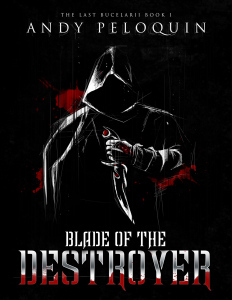 The Hunter of Voramis is the perfect assassin: ruthless, unrelenting, immortal. Yet he is haunted by lost memories, bonded to a cursed dagger that feeds him power yet denies him peace of mind. Within him rages an unquenchable need for blood and death.
The Hunter of Voramis is the perfect assassin: ruthless, unrelenting, immortal. Yet he is haunted by lost memories, bonded to a cursed dagger that feeds him power yet denies him peace of mind. Within him rages an unquenchable need for blood and death.
When he accepts a contract to avenge the stolen innocence of a girl, the Hunter becomes the prey. The death of a seemingly random target sends him hurtling toward destruction, yet could his path also lead to the truth of his buried past?
Amazon ~ Goodreads ~ Andy’s Website
The post Dream Up A Great Book Idea & Make Something Of It appeared first on WRITERS HELPING WRITERS™.
September 26, 2015
Emotional Wounds Thesaurus Entry: Becoming a Caregiver at a Young Age
When you’re writing a character, it’s important to know why she is the way she is. Knowing her backstory is important to achieving this end, and one of the most impactful pieces of a character’s backstory is her emotional wound. This negative experience from the past is so intense that a character will go to great lengths to avoid experiencing that kind of pain and negative emotion again. As a result, certain behaviors, beliefs, and character traits will emerge.
Characters, like real people, are unique, and will respond to wounding events differently. The vast array of possible emotional wounds combined with each character’s personality gives you many options in terms of how your character will turn out. With the right amount of exploration, you should be able to come up with a character whose past appropriately affects her present, resulting in a realistic character that will ring true with readers. Understanding what wounds a protagonist bears will also help you plot out her arc, creating a compelling journey of change that will satisfy readers.
NOTE: We realize that sometimes a wound we profile may have personal meaning, stirring up the past for some of our readers. It is not our intent to create emotional turmoil. Please know that we research each wounding topic carefully to treat it with the utmost respect.
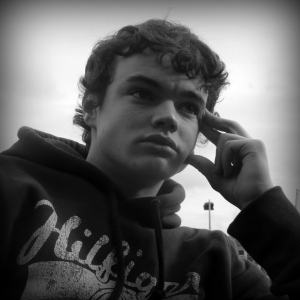
Courtesy: Sophie & Cie at Creative Commons
Examples:
Having to take care of younger siblings because one’s parent is neglectful, absentee, mentally ill, or an addict
Taking full responsibility (as a new adult) of younger siblings upon the death of one’s parents
Having to care for an ill or incapacitated parent
Taking on the roles of an absent father or mother
Basic Needs Often Compromised By This Wound: physiological needs, safety and security, love and belonging, esteem and recognition, self-actualization
False Beliefs That May Be Embraced As a Result of This Wound:
I am the only person who can keep us afloat.
Adults can’t be trusted.
I’m as capable as any adult.
This is the way my life is always going to be.
I’ll never be able to do what I want to do.
Wanting things for myself is selfish and counter-productive.
I have value because others need me.
I don’t need anyone’s help.
Asking for help is sign of weakness.
Being upset about my circumstances is a sign of ingratitude.
Emotions are pointless and only get in the way.
Other peoples’ needs are more important/have more weight than my own.
I’ll never achieve my dreams so there’s no point in having them.
Positive Attributes That May Result: bold, cautious, disciplined, discreet, focused, gentle, honorable, independent, industrious, mature, meticulous, organized, persistent, private, protective, resourceful, responsible, sensible, thrifty, unselfish
Negative Traits That May Result: addictive, callous, compulsive, controlling, cynical, evasive, fussy, humorless, impatient, inflexible, inhibited, obsessive, perfectionist, promiscuous, rebellious, resentful, stubborn, uncooperative, withdrawn, worrywart
Resulting Fears:
Fear of losing something in one’s charge
Fear of important details slipping through the cracks
Fear of someone discovering a shameful secret (that one’s parent is an alcoholic, that one’s parent has abandoned his/her family, that the home is embarrassingly messy, threadbare, or unattractive)
Fear of losing something that is important to one’s survival (a job, reliable transportation, one’s health, mobility, etc.)
Fear of becoming like the adult one is caring for
Fear of becoming like the abandoning/neglectful/absentee adult
Fear of the authorities finding out (if the responsible one is a minor)
Fear of feeling or expressing certain emotions
Fear of not being needed/not having someone to care for
Possible Habits That May Emerge:
Taking on and succeeding at jobs one didn’t know one could do; being a risk-taker
Putting oneself last (taking on extra jobs, going without sleep or food, etc.)
Anticipating the needs of others; showing empathy
Becoming hyper-cautious about safety, hygiene, and other factors that affect one’s ability to care for others
Over-protecting the people in one’s charge
Resenting peers who have fewer responsibilities
Distrusting people in authority
Perfectionism
Becoming evasive, withdrawn, or deceptive (if one has a secret to keep)
Repressing one’s emotions
Having no patience for frivolity or “silly” endeavors
Losing touch with one’s peer group
Gravitating toward more mature peers
Giving up hobbies, interests, and friends due to having no time for them
TIP: If you need help understanding the impact of these factors, please read our introductory post on the Emotional Wound Thesaurus. For our current list of Emotional Wound Entries, go here.
For other Descriptive Thesaurus Collections, go here.
The post Emotional Wounds Thesaurus Entry: Becoming a Caregiver at a Young Age appeared first on WRITERS HELPING WRITERS™.
September 23, 2015
Voice: The Soul of your Story
One of my favorite parts of writing conferences is the first-page critique session—when attendees anonymously submit their first pages and a panel of editors, agents, and industry pros critique them for the whole group. It’s interesting, because the panelists always complain about the same things, and one of the common fails on ailing first pages is the voice.
If the voice on a first page is boring or flat or inconsistent, you may not be able to put your finger on exactly what’s wrong with it, but you know something’s wrong. Likewise, when the voice is on, you sense it immediately. It resonates. So if you’re wanting to write a book that people will want to read, it’s hugely important to get the voice right.
That’s why, despite this topic having been discussed already around the blogosphere, we’re going to talk about it again. It’s that important. PK Hrezo is here today to share some thoughts and an exercise on how to write voice well. Thanks, PK!
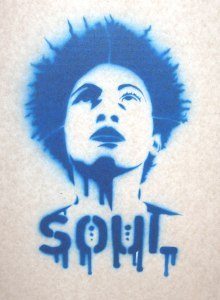
Courtesy: asboluv @ Creative Commons
Soul. It’s a word applied to many different media. For just a moment, let’s consider it from a musical standpoint. Stevie Wonder. Aretha Franklin. Marvin Gaye. Not just anyone can sing and play this kind of music successfully; a certain je ne sais quoi is required in bringing down the house and moving people to their very souls.
Is it really any different when it comes to books?
If the structure of a story is the bones and the characters and plot are the meat, then the voice most certainly is the soul. Every reader loves a good plot and riveting characters, and many books have these elements, but with so many to choose from, what makes us select the books we do?
For me it’s simple: if you want me to get past the first page of your book, the voice of the story must grab me. It must be authentic, unique, memorable. It should feel like a real person. So what ingredients make up that magical concoction of a compelling voice?
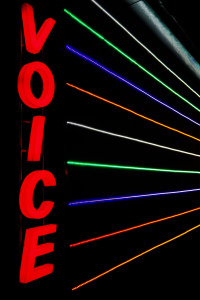
Courtesy: Matthias Ripp @ CC
Word choice. Cadence. Rhythm. It’s where the real writing comes in, paired with crafty prose and flipped clichés. It requires careful thought and consideration, both when the narrator is a main character, as well as when the story is told in third person.
For newer writers, it can be hard to decipher what those editors and reviewers are saying when they mention a weak or bland voice. It’s like not being able to see the book for the words. (See how I flipped that forest-for-the-trees cliché??)
If you’re struggling with the concept of voice, give the following exercise a try:
Let’s say we send three very different people to the same party, asking all to observe the venue and guests for thirty minutes before reporting back on everything they noticed. Let’s say one of those people is an elderly lady who uses a walker, is blind in one eye, and hasn’t been out of her house in a week. How would she describe what she sees and feels? What words would she choose? What are the things she’d notice?
What if one of the guests was a young dad who’d recently lost his wife to cancer and this was the first time he’d been out since her death? How would his observations be different from the old woman? How would he describe it, in his own overwhelmed, brink-of-depression terms?
What if one of those people was an eighteen-year-old girl who was just elected homecoming queen and this was her third party of the night? What words would she use to make her report relative to her world?
This activity exemplifies the importance of character when it comes to voice. What she notices (and doesn’t notice), the words she uses to describe those things, the cadence and rhythm of her speech (is it lilting, rambling, stuttering, or staccato?)—all of these things go together to define her voice and make it uniquely hers.
Now take the exercise a step further. Make your main character one of these guests who must observe the party and report back. Now it’s your villain’s turn. Now the love interest…Not only will this activity get you in touch with who your characters are at their core, but it will distinguish each of their unique voices and help you decide which one would be the most compelling and/or fitting for the story you want to tell. The individual voices that result can be the difference in an un-put-downable story and one that sounds like all the rest.
When I’m drafting, I work fast. I get that story down and focus on the rise and fall of emotion throughout the plot. But I know that a compelling narrator voice is vital, so during my first and second rounds of edits, I focus on how I can strengthen the narrator (and character) voice. Are my word choices dull? If the sentence or paragraph evokes no emotion in me, then the answer is probably yes. How can I flip my current word choices to add flair to my character and refine her voice in the story?
Example from an old unpublished manuscript:
It’s not crowded, but the noise of the arcade and music makes it seem busy. Glancing around, I notice some of my old video game faves. I haven’t been inside here in ages—grew out of it, I guess. Now it seems kind of fun, though. Reminds me of a time when nothing else mattered—when scoring high at Zombie Slayer ruled the weekend. Back when my brother Jake was still at home, and when Mom and I got along. I realize it now. Something about this place comforts me.
Now, using the same scenario, let’s tweak the voice:
The place is a ghost town, only the whirrs and beeps of the player-starved arcades giving it any life. Glancing around, I notice my faithful old time-killers and a flash of nostalgia sweeps through me. I haven’t been inside this pizza joint in moons—not since middle school, anyway. It reminds me of a time when nothing else mattered, a time when scoring high at Zombie Slayer was the highest honor of the weekend. Of a time when my big brother was still at home, and when Mom and I still got along.
Which narrator would you rather keep reading? Both tell the same story, but the second one gives more insight into who the character is, and it’s more entertaining.
In closing, I should add that, like a fine wine, our writer’s ear for voice matures over time. If you’re just starting out, you may not notice anything missing in your story, while an agent or editor or reviewer may say that the voice was “flat” or “inconsistent.” This just means there’s room for growth in this area.
Ask around for suggestions on books with compelling narrator voices. Read them, focusing on the author’s word choice, cadence, and rhythm. Once you read a story with a strong voice, you’ll know it; recognize the techniques, practice them yourself, and the knowledge will change your work for the better.
Thanks to Angela and Becca for having me here today!
Thanks for being here, PK! Voice is honestly one of those things that can make or break a story, and the best way I’ve found to improve in this area myself is to identify books that have a strong voice and study them. A few of my personal favorites? Chime (Franny Billingsley), The Wicked and the Just (J. Anderson Coats), and Above (Leah Bobet). What books stand out to you as have strong and unique voices?
PK Hrezo is the author of the Butterman (Time) Travel, Inc. series. She is also a blogger and crafter. Follow her down the rabbithole at her website.
The post Voice: The Soul of your Story appeared first on WRITERS HELPING WRITERS™.
Writers Helping Writers
- Angela Ackerman's profile
- 1022 followers


